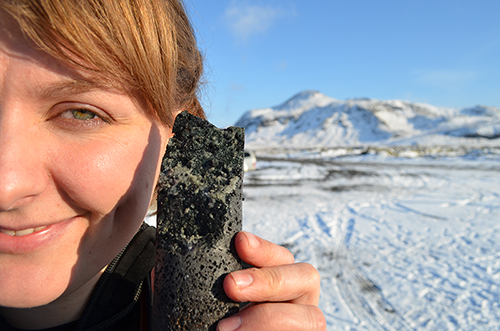Hellisheidi power plant in Iceland is the world's largest geothermal facility and now it has one other distinction. Engineers there have shown that carbon dioxide emissions can be pumped into the earth and changed chemically to stone within months, far faster than believed.
Iceland has the benefit of geothermal energy, they can pump up volcanically heated water to run turbines. But it is not completely clean; it also brings up volcanic gases, including carbon dioxide and nasty-smelling hydrogen sulfide. Meanwhile, other parts of the world are considering capture of CO2 but are concerned that emissions could seep back into the air, or even explode. Writing in Science, scientists describe how engineers put together a pilot project called Carbfix, which mixes the gases with the water pumped from below and reinjecting the solution into the volcanic basalt below.
When basalt is exposed to carbon dioxide and water, a series of natural chemical reactions takes place, and the carbon precipitates out into a whitish, chalky mineral. But no one knew how fast this might happen if the process were harnessed for carbon storage. Previous studies have estimated that in most rocks, it would take hundreds or even thousands of years. In the basalt below Hellisheidi, 95 percent of the injected carbon was solidified within less than two years.

"This means that we can pump down large amounts of CO2 and store it in a very safe way over a very short period of time," said study coauthor Martin Stute, a hydrologist at Columbia University's Lamont-Doherty Earth Observatory. "In the future, we could think of using this for power plants in places where there's a lot of basalt--and there are many such places." Basically all the world's seafloors are made of the porous, blackish rock, as are about 10 percent of continental rocks.
Carbon capture and sequestration sound great, Exxon is building fuel cells that turn CO2 to energy, and initiative by Ford is convert emissions to solid foams to build the interiors of vehicles. In a project in Oman, a group is looking into pumping emissions into a different kind of rock, peridotite, which may react even more rapidly with CO2. Such projects have made little progress. Scientists have worried that any miscalculation could result in emissions making their way back up through fractures, or that natural earthquakes or tremors caused by the injection itself could rupture subterranean reservoirs. A coal-fired power plant in Saskatchewan that currently runs North America's only large-scale operation at a generating station has been plagued by technical problems and the captured carbon dioxide is being sent to oil producers who inject it into ailing wells to pressure out more oil, which produces more carbon dioxide when burned.
Even being geothermal, Hellisheidi produces 40,000 tons of CO2 a year, 5 percent the emissions of an equivalent coal-fired plant, but still considerable. Lab experiments showed that, unlike the sedimentary rocks that most other projects have used for injection, the local basalt contains plenty of calcium, iron and magnesium, which are needed to precipitate out carbon. Experiments showed that large amounts of water would also have to be added to make the reaction go--another departure from previous projects, which have just pumped down pure carbon dioxide.
In a 2012-2013 pilot, the team piped 250 tons of CO2 mixed with water and hydrogen sulfide down 400 to 800 meters, then monitored the formation's chemistry through a series of wells. Fast-changing compositions of carbon isotopes in water samples, initially reported in 2014, signaled that much of the carbon had mineralized within months. The new Science paper lays out the evidence conclusively.
Edda Aradottir, who heads the project for Reykjavik Energy, initially estimated the solidification process might take 8 to 12 years, much faster than previous studies had indicated. "People said there was very little truth to that--they thought it couldn't happen that fast," she said. "Then, it happened much faster. It was a very welcome surprise." Cores drilled from the injected area show the rock is heavily laced with whitish carbonate veins, apparently produced by the process. With initial signs of success, in 2014 Reyjavik Energy started injecting carbon dioxide at the rate of 5,000 tons per year. Ongoing monitoring indicates that mineralization has kept pace, said Aradottir. This summer, the company plans to double the injection rate, she said.
Its greatest promise would be with fossil-fuel-powered plants, smelters and other heavy industries that produce far more emissions, but obstacles are the basalt and the water required--about 25 tons for every ton of CO2. Seawater could be used. A 2010 study has already outlined basaltic seafloors off U.S. coasts that could be used to take up emissions. Separation and injection of CO2 in most other projects has been estimated to cost a steep $130 or so a ton. The Hellisheidi operation has an advantage in that it largely uses the plant's existing infrastructure to reinject the solution, and doesn't bother purifying the CO2. Its cost is only $30 a ton, said Aradottir.
Another possible hitch is that subterranean microbes seem capable of feeding off carbonate minerals and using them to release methane, which has gotten attention from environmental activists as CO2 levels have declined.





Comments